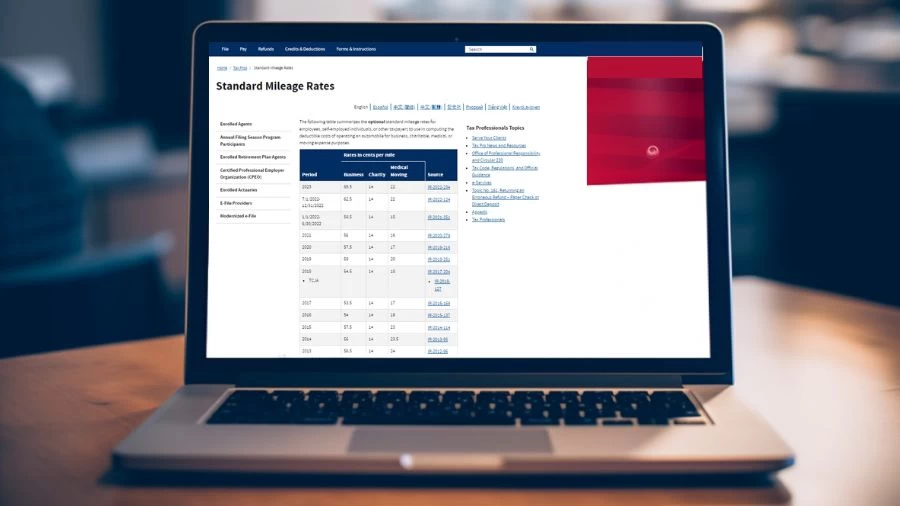
IRS Standard Mileage Rate 2023, How to Calculate IRS Standard Mileage Rate?
The 2023 IRS mileage rates, with a 65.5 cents per mile business rate increase, impact businesses' reimbursement expenses and budget planning for employee vehicle use.
by Sai V
Updated Sep 13, 2023
On This Page
- IRS Standard Mileage Rate 2023
- How to Calculate IRS Standard Mileage Rate?
- What is the 2023 Mileage Reimbursement Rate in CT?
- What is the IRS Mileage Rate for Medical and Moving Expenses in 2023?
- How Can I Maximize Tax Deductions Using IRS Mileage Rates for 2023?
- What Are the Rules for IRS Mileage Reimbursement?
- What is the Impact of the 2023 IRS Mileage Rate on Your Business?
IRS Standard Mileage Rate 2023
The IRS Standard Mileage Rate for 2023 is a set of rates established by the Internal Revenue Service (IRS) in the United States. These rates are used to calculate the deductible costs associated with operating a vehicle for various purposes, including business, charitable, medical, or moving purposes, for federal income tax purposes. Taxpayers have the option to use these standard mileage rates or calculate the actual expenses incurred while using their vehicle.
Rates for 2023
For the tax year 2023, the IRS has released the following standard mileage rates:
Business Use: The standard mileage rate for business use is 65.5 cents per mile driven. This rate has increased by 3 cents per mile compared to the rate set for the second half of 2022. Business use typically refers to any driving related to work, such as meetings with clients, traveling between job sites, or other business-related activities.
Medical or Moving Purposes for Qualified Active-Duty Members of the Armed Forces: The standard mileage rate for medical or moving purposes for qualified active-duty members of the Armed Forces is 22 cents per mile driven. This rate remains consistent with the increased midyear rate set for the second half of 2022. It applies to military personnel who are relocating due to orders.
Service of Charitable Organizations: The standard mileage rate for driving in service of charitable organizations is 14 cents per mile driven. This rate is set by statute and remains unchanged from 2022. It applies to volunteers who use their vehicles for charitable activities.
How to Calculate IRS Standard Mileage Rate?
Determine the Applicable Rate:
To calculate the IRS Standard Mileage Rate accurately, it's essential to first identify the appropriate rate to use for your specific purpose. The IRS publishes these rates annually and may have different rates for various purposes, such as business, medical, moving, or charitable activities. Here's how to go about this step:
- Visit IRS Resources: Access the IRS website or refer to official IRS publications, which are reliable sources for up-to-date information regarding the standard mileage rates. These resources typically provide the current rates and any specific guidelines or changes for each category of mileage.
- Select the Relevant Rate: Determine which standard mileage rate corresponds to your specific purpose. For instance, if you are calculating deductions for business-related mileage, find the standard mileage rate designated for business use. It's important to use the correct rate because different purposes may have different rates.
Multiply the Miles by the Rate:
Once you've identified the appropriate standard mileage rate for your purpose, you can proceed to calculate your deductible expenses based on the miles you've driven. Here's how to do it:
- Gather Mileage Information: Compile the total number of miles you've driven for the particular purpose for which you're seeking a deduction. This may involve reviewing your mileage log or records to ensure accuracy.
- Apply the Formula: Use the straightforward formula: Deductible Expense = Total Miles Driven x Standard Mileage Rate. Insert the total miles driven and the applicable standard mileage rate into the formula.
Example Calculation:
Let's consider an example. Suppose you drove 5,000 miles for business purposes, and the IRS standard mileage rate for business use is 58 cents per mile. To calculate your deductible expenses, apply the formula:
Deductible Expense = 5,000 miles x $0.58 = $2,900
In this scenario, your deductible expense for business mileage would amount to $2,900, which you can use when preparing your tax return.
What is the 2023 Mileage Reimbursement Rate in CT?
The mileage reimbursement rate for 2023 in Connecticut is set at 65.5 cents per mile. This rate applies to all travel expenses incurred on or after January 1, 2023, and it affects all claimants, regardless of their injury date. The adjustment in the mileage reimbursement rate aligns with the federal mileage reimbursement rate specified in Section 31-312(a) of the Workers Compensation Act.
This rate increase is significant as it reflects the changing economic landscape and the rising costs associated with travel. Employers and organizations in Connecticut are mandated to adhere to this new rate when reimbursing their employees for business-related mileage expenses. It is essential for both employers and employees to be aware of this rate to ensure accurate and fair reimbursement for travel expenditures.
What is the IRS Mileage Rate for Medical and Moving Expenses in 2023?
IRS Mileage Rate for Medical Expenses in 2023
In 2023, the IRS standard mileage rate for qualified active-duty members of the Armed Forces who incur medical expenses while relocating remains at 22 cents per mile driven. This rate is applicable to military personnel who are required to move due to orders and need to calculate deductible expenses related to medical travel. To determine the deductible amount, individuals should accurately record the number of miles driven for medical purposes and multiply it by the specified rate.
IRS Mileage Rate for Moving Expenses in 2023
For individuals who are not part of the Armed Forces but are relocating for work or other qualified reasons, the IRS standard mileage rate for moving expenses in 2023 is 22 cents per mile driven as well. This rate applies to those who meet the IRS criteria for moving expense deductions. To calculate deductible moving expenses, individuals should maintain detailed records of the miles driven during the move and then use the IRS-approved mileage rate for their calculations, ensuring compliance with tax regulations.
How Can I Maximize Tax Deductions Using IRS Mileage Rates for 2023?
To maximize tax deductions using IRS Mileage Rates for 2023, it's crucial to keep meticulous records of your mileage for various purposes, such as business, medical, moving, or charitable activities. Start by visiting the official IRS website or referring to IRS publications to identify the correct standard mileage rate applicable to each specific use case. Once you've determined the appropriate rate, multiply the total miles driven for each purpose by the corresponding rate to calculate deductible expenses.
For instance, if you're self-employed or use your vehicle for business purposes, accurately tracking and calculating your business mileage can lead to significant tax savings. Staying informed about any updates or changes to the IRS mileage rates is also essential to ensure you are maximizing your deductions within the legal guidelines provided by the IRS. By following these steps and maintaining accurate records, you can effectively leverage IRS mileage rates to optimize your tax deductions for the tax year 2023.
What Are the Rules for IRS Mileage Reimbursement?
The IRS governs mileage reimbursement rules, annually setting rates for business and medical travel. Charitable rates remain constant, while these rules encompass variable and fixed costs for vehicles, including gas, maintenance, and insurance. These regulations apply exclusively to the automobile sector and exclude parking and toll expenses, providing a consistent framework for reimbursement nationwide."
Understand the Annual Rate Changes
The IRS sets new mileage reimbursement rates for different types of travel each year. These rates are subject to change annually, so it's essential to stay updated.
Different Rates for Different Purposes
There are separate mileage reimbursement rates for different purposes:
- Business Travel
- Medical Moving Travel
- Charitable Activities
Components of Village Rates
The mileage reimbursement rates for business and medical moving travel encompass various cost components. These include both variable costs (such as fuel, oil, tires, maintenance, and repairs) and fixed costs (including insurance, registration, and depreciation or lease payments) associated with operating a vehicle.
Applicability
These rules primarily apply to the automobile sector. They are relevant for businesses, individuals with medical-related travel, and those engaged in charitable activities.
Uniform Mileage Rates
Regardless of your geographical location within the United States, the mileage reimbursement rates remain consistent. In other words, the rates are standardized nationally.
Excluded Expenses
Keep in mind that the mileage reimbursement rates do not cover the cost of parking and tolls. If you incur these expenses during your travel, they need to be reimbursed separately or accounted for in your tax filings.
What is the Impact of the 2023 IRS Mileage Rate on Your Business?
The 2023 IRS mileage rate increase has the potential to significantly impact businesses, given the rising costs associated with operating vehicles. Even though the rate hike may seem relatively small, it can lead to substantial additional expenses when multiplied by the business miles driven by each team member.
Companies should be prepared to adjust their budgets to accommodate these increased reimbursement costs, which can affect overall financial planning. To mitigate these expenses and enhance accountability, reliable mileage tracking apps are recommended as they ensure accurate mileage recording and provide a valuable tool for managing business-related transportation costs efficiently.
IRS Standard Mileage Rate 2023 - FAQs
1. What is the IRS Standard Mileage Rate for business use in 2023?
The IRS Standard Mileage Rate for business use in 2023 is 65.5 cents per mile.
2. Does the 2023 IRS mileage rate apply uniformly across the United States?
Yes, the mileage reimbursement rates are standardized nationally and apply consistently nationwide.
3. What is the mileage reimbursement rate for moving expenses in 2023?
The mileage reimbursement rate for moving expenses in 2023 is also 22 cents per mile.
4. How can I maximize tax deductions using IRS Mileage Rates for 2023?
To maximize tax deductions, keep accurate mileage records and use the correct IRS rate for each specific purpose, such as business, medical, moving, or charitable activities.
5. What is the impact of the 2023 IRS mileage rate increase on businesses?
The 2023 IRS mileage rate increase can significantly impact businesses by increasing reimbursement costs for employees' business-related mileage, requiring budget adjustments and meticulous record-keeping.




